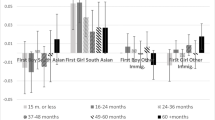Abstract
This paper examines the values, variance and some possible determinants of sex ratios for the first child and for all children in expected and desired families. For adults in Tallahassee, Florida, it was found that a large majority of respondents within sixty demographic categories chose males for their first child. Of those who actually had girls for their first child, a plurality would, nevertheless, prefer a first boy in their desired family. It was hypothesized and demonstrated that sex-role ideologies were a strong predictor of variance in first-child sex preferences. Sex ratios for all children in expected and desired families were 116 and 113, respectively. If people could choose the sex of their future children, these data suggest that several population parameters might be significantly altered; a preliminary model is outlined which might project some of these changes.
Similar content being viewed by others
References
Dawes, R. M. 1970. Sexual Heterogeneity of Children as a Determinant of American Family Size. Oregon Research Bulletin 10, No. 8.
Dinitz, S., R. Dynes, and A. Clark. 1964. Preference for Male or Female Children: Traditional or Affectional. Journal of Marriage and Family Living 16:128–130.
Duncan, Otis Dudley, and Beverly Duncan. 1955. Residential Distribution and Occupational Stratification. American Journal of Sociology 60:494–503.
Etzioni, Amitai. 1968. Sex Control, Science, and Society. Science 161:1007–1012.
Goodman, Leo. 1961. Some Possible Effects of Birth Control on the Human Sex Ratio. Annals of Human Genetics 25:75–81.
Hill, R., J. Mayone Stycos, and K. Back. 1959. The Family and Population Control. Chapel Hill: University of North Carolina Press.
Hoffman, L. W. 1960. Effects of Employment of Mothers on the Parental Power Relations and the Division of Household Labor. Journal of Marriage and Family Living 22: 27–35.
Keyfitz, Nathan, and Wilhelm Flieger. 1971. Population: Facts and Methods of Demography. San Francisco: W. H. Freeman and Company.
Lerner, I. M. 1968. Heredity, Evolution and Society. San Francisco: W. H. Freeman and Company.
Lyster, W. R. 1970. Sex Ratio in the Australian Capitol Territory. Human Biology 42:670–678.
Markle, Gerald E. 1973. The Potential Impact of Sex Predetermination on Fertility. Unpublished Ph.D. Dissertation. Tallahassee: Florida State University.
—, and Charles B. Nam. 1971. Sex Predetermination: Its Impact on Fertility. Social Biology, 18:73–78.
May, David gnA., and David M. Heer. 1968. Son Survivorship Motivation and Family Size in India: A Computer Simulation. Population Studies 22: 199–210.
Nam, Charles B., and Mary G. Powers. 1968. Changes in the Relative Status Level of Workers in the United States, 1950–1960. Social Forces 47: 158–170.
Teitelbaum, Michael S. 1972. Factors Associated with the Sex Ratio in Human Populations. Pp, 90–109 in G. A. Harrison and A. J. Boyce (eds.), The Structure of Human Populations. London: Oxford University Press.
Teitelbaum, Michael S. 1970. Factors Affecting the Sex Ratios in Large Populations. In Biosocial Aspects of Sex. Journal of Biosocial Science, Supplement No.2.
— and Nathan Mantel. 1971. Socioeconomic Factors and the Sex Ratio at Birth. Journal of Biosocial Science 3:23–41.
. S. Department of Health, Education and Welfare 1968. Vital Statistics of the United States. Washington, D.C.: Government Printing Office.
Visaria, Pravin M. 1967. Sex Ratio at Birth in Territories with Relatively Complete Registration. Eugenics Quarterly 14:132–142.
Westoff, Charles F., Philip C. Sagi, and Elliot G. Mishler. 1961. Family Growth in Metropolitan America. Princeton: Princeton University Press.
Williamson, N. E. 1973. Preferences for Sons Around the World. Unpublished Ph.D. dissertation. Cambridge: Harvard University.
Author information
Authors and Affiliations
Rights and permissions
About this article
Cite this article
Markle, G.E. Sex ratio at birth: Values, variance, and some determinants. Demography 11, 131–142 (1974). https://doi.org/10.2307/2060704
Issue Date:
DOI: https://doi.org/10.2307/2060704




